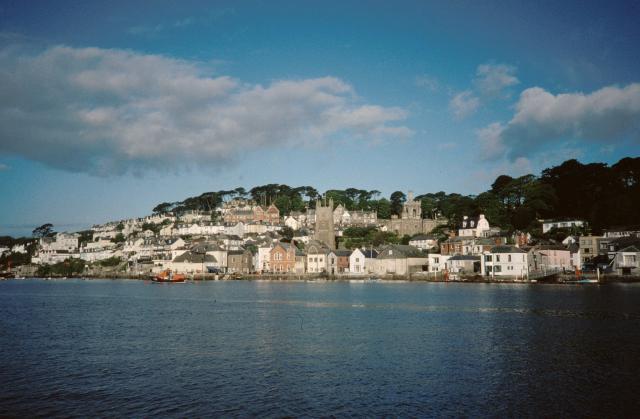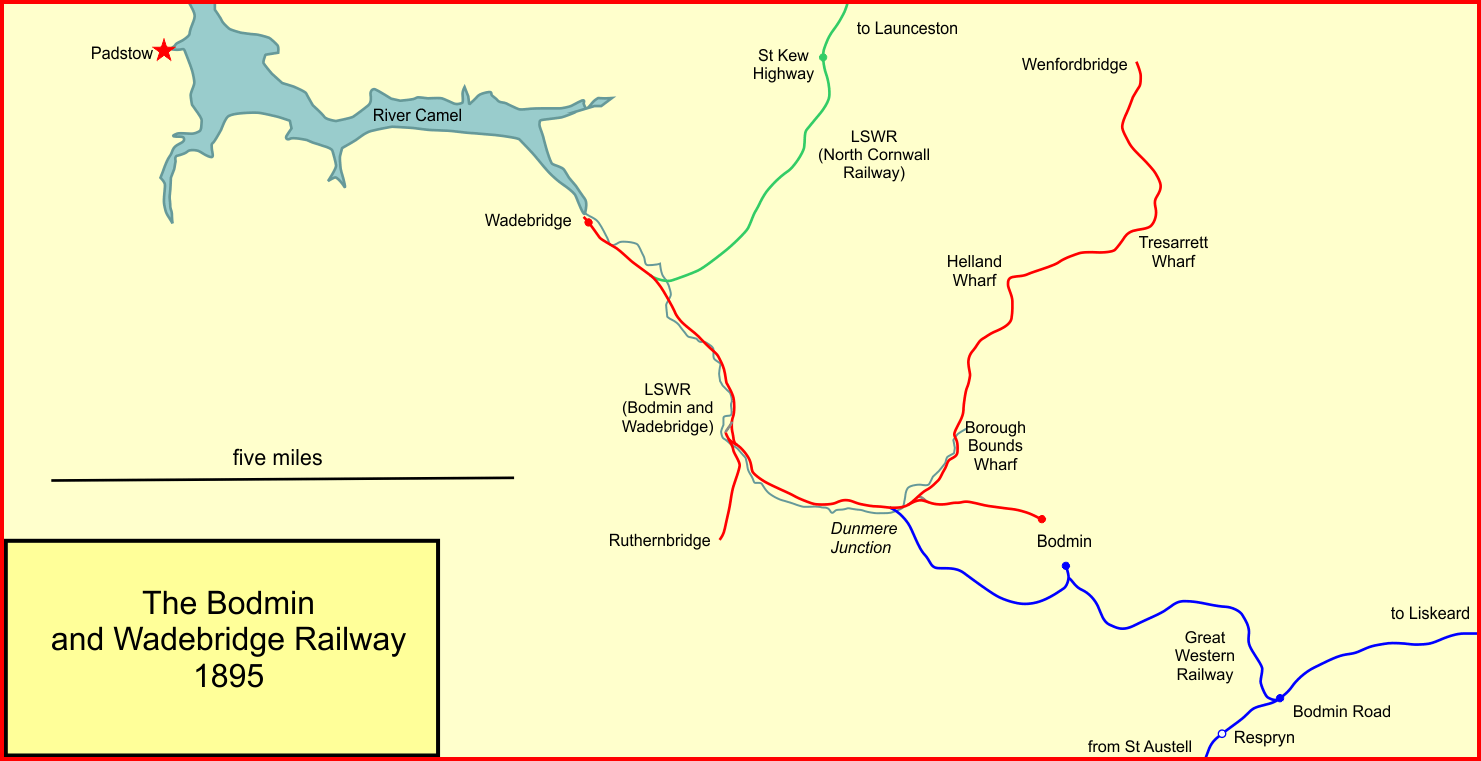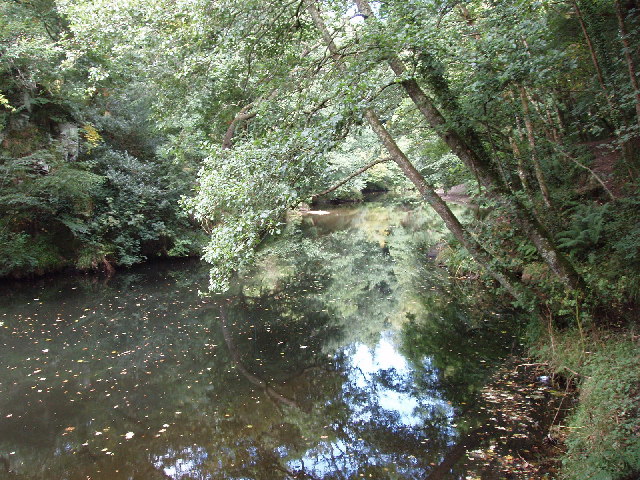|
Boscarne Junction Railway Station
Boscarne Junction railway station is a railway station on the Bodmin and Wenford Railway in Cornwall, United Kingdom, and is its current terminus of the railway. It is adjacent to the Camel Trail, a long-distance footpath and cycle trail. In earlier days it was the junction for lines to and to Padstow and Wenfordbridge. History Boscarne Junction was created in 1888 when the Great Western Railway built a line to connect from their Bodmin General railway station to the Bodmin and Wadebridge Railway. Originally there was a loop on either side of the line, each straddling the junction which was controlled by a signal box; a second and longer loop was added from the signal box extending down the Wenfordbridge line well beyond the junction before 1911. The purpose of the GWR line was to take china clay from Wenford clay dries to the docks at Fowey, the traffic having previously been taken by the Bodmin and Wenford Railway to . From 15 June 1964 to 18 April 1966 a small halt ... [...More Info...] [...Related Items...] OR: [Wikipedia] [Google] [Baidu] |
Heritage Railway
A heritage railway or heritage railroad (US usage) is a railway operated as living history to re-create or preserve railway scenes of the past. Heritage railways are often old railway lines preserved in a state depicting a period (or periods) in the history of rail transport. Definition The British Office of Rail and Road defines heritage railways as follows:...'lines of local interest', museum railways or tourist railways that have retained or assumed the character and appearance and operating practices of railways of former times. Several lines that operate in isolation provide genuine transport facilities, providing community links. Most lines constitute tourist or educational attractions in their own right. Much of the rolling stock and other equipment used on these systems is original and is of historic value in its own right. Many systems aim to replicate both the look and operating practices of historic former railways companies. Infrastructure Heritage railway lines ... [...More Info...] [...Related Items...] OR: [Wikipedia] [Google] [Baidu] |
Great Western Railway
The Great Western Railway (GWR) was a British railway company that linked London with the southwest, west and West Midlands of England and most of Wales. It was founded in 1833, received its enabling Act of Parliament on 31 August 1835 and ran its first trains in 1838 with the initial route completed between London and Bristol in 1841. It was engineered by Isambard Kingdom Brunel, who chose a broad gauge of —later slightly widened to —but, from 1854, a series of amalgamations saw it also operate standard-gauge trains; the last broad-gauge services were operated in 1892. The GWR was the only company to keep its identity through the Railways Act 1921, which amalgamated it with the remaining independent railways within its territory, and it was finally merged at the end of 1947 when it was nationalised and became the Western Region of British Railways. The GWR was called by some "God's Wonderful Railway" and by others the "Great Way Round" but it was famed as the "Holiday ... [...More Info...] [...Related Items...] OR: [Wikipedia] [Google] [Baidu] |
Railway Stations Built For UK Heritage Railways
Rail transport (also known as train transport) is a means of transport that transfers passengers and goods on wheeled vehicles running on rails, which are incorporated in tracks. In contrast to road transport, where the vehicles run on a prepared flat surface, rail vehicles (rolling stock) are directionally guided by the tracks on which they run. Tracks usually consist of steel rails, installed on sleepers (ties) set in ballast, on which the rolling stock, usually fitted with metal wheels, moves. Other variations are also possible, such as "slab track", in which the rails are fastened to a concrete foundation resting on a prepared subsurface. Rolling stock in a rail transport system generally encounters lower frictional resistance than rubber-tyred road vehicles, so passenger and freight cars (carriages and wagons) can be coupled into longer trains. The operation is carried out by a railway company, providing transport between train stations or freight customer faciliti ... [...More Info...] [...Related Items...] OR: [Wikipedia] [Google] [Baidu] |
Railway Stations In Great Britain Opened In 1997
Rail transport (also known as train transport) is a means of transport that transfers passengers and goods on wheeled vehicles running on rails, which are incorporated in tracks. In contrast to road transport, where the vehicles run on a prepared flat surface, rail vehicles (rolling stock) are directionally guided by the tracks on which they run. Tracks usually consist of steel rails, installed on sleepers (ties) set in ballast, on which the rolling stock, usually fitted with metal wheels, moves. Other variations are also possible, such as "slab track", in which the rails are fastened to a concrete foundation resting on a prepared subsurface. Rolling stock in a rail transport system generally encounters lower frictional resistance than rubber-tyred road vehicles, so passenger and freight cars (carriages and wagons) can be coupled into longer trains. The operation is carried out by a railway company, providing transport between train stations or freight customer faciliti ... [...More Info...] [...Related Items...] OR: [Wikipedia] [Google] [Baidu] |
Boscarne Exchange Platform Railway Station
There are eight disused railway stations between Wadebridge and Bodmin North on the former Bodmin and Wadebridge Railway in Cornwall, in the United Kingdom, with ten other closed sidings on the branches to Ruthern Bridge and Wenfordbridge. The section from Boscarne Junction to Bodmin General is currently part of the Bodmin and Wenford Steam Railway; the line from Wadebridge to Wenfordbridge is now part of the Camel Trail, and the line to Ruthern Bridge can be followed for much of its length as it runs parallel to a public road. Background The Bodmin and Wadebridge Railway (B&W) opened in 1834 to carry sand brought up the River Camel for use as a soil improver. Extensions were added to Wenfordbridge and Ruthern Bridge to handle freight traffic later that year, particularly stone from the De Lank quarry and Tin from the Mulberry mine. In 1847 the London and South Western Railway bought the B&W, and connections to the parent company came via the North Cornwall Line in 1895. Con ... [...More Info...] [...Related Items...] OR: [Wikipedia] [Google] [Baidu] |
Fowey
Fowey ( ; kw, Fowydh, meaning 'Beech Trees') is a port town and civil parish at the mouth of the River Fowey in south Cornwall, England, United Kingdom. The town has been in existence since well before the Norman invasion, with the local church first established some time in the 7th century; the estuary of the River Fowey forms a natural harbour which enabled the town to become an important trading centre. Privateers also made use of the sheltered harbourage. The Lostwithiel and Fowey Railway brought China clay here for export. History Early history The Domesday Book survey at the end of the 11th century records manors at Penventinue and Trenant, and a priory was soon established nearby at Tywardreath. the prior granted a charter to people living in Fowey itself. This medieval town ran from a north gate near Boddinick Passage to a south gate at what is now Lostwithiel Street; the town extended a little way up the hillside and was bounded on the other side by the river where ... [...More Info...] [...Related Items...] OR: [Wikipedia] [Google] [Baidu] |
China Clay
Kaolinite ( ) is a clay mineral, with the chemical composition Al2 Si2 O5( OH)4. It is an important industrial mineral. It is a layered silicate mineral, with one tetrahedral sheet of silica () linked through oxygen atoms to one octahedral sheet of alumina () octahedra. Rocks that are rich in kaolinite are known as kaolin () or china clay. Kaolin is occasionally referred to by the antiquated term lithomarge, from the Ancient Greek ''litho-'' and Latin ''marga'', meaning 'stone of marl'. Presently the name lithomarge can refer to a compacted, massive form of kaolin. The name ''kaolin'' is derived from Gaoling (), a Chinese village near Jingdezhen in southeastern China's Jiangxi Province. The name entered English in 1727 from the French version of the word: , following François Xavier d'Entrecolles's reports on the making of Jingdezhen porcelain. Kaolinite has a low shrink–swell capacity and a low cation-exchange capacity (1–15 meq/100 g). It is a soft, earthy, usu ... [...More Info...] [...Related Items...] OR: [Wikipedia] [Google] [Baidu] |
Signal Box
In signal processing, a signal is a function that conveys information about a phenomenon. Any quantity that can vary over space or time can be used as a signal to share messages between observers. The ''IEEE Transactions on Signal Processing'' includes audio, video, speech, image, sonar, and radar as examples of signal. A signal may also be defined as observable change in a quantity over space or time (a time series), even if it does not carry information. In nature, signals can be actions done by an organism to alert other organisms, ranging from the release of plant chemicals to warn nearby plants of a predator, to sounds or motions made by animals to alert other animals of food. Signaling occurs in all organisms even at cellular levels, with cell signaling. Signaling theory, in evolutionary biology, proposes that a substantial driver for evolution is the ability of animals to communicate with each other by developing ways of signaling. In human engineering, signals are typi ... [...More Info...] [...Related Items...] OR: [Wikipedia] [Google] [Baidu] |
Bodmin And Wadebridge Railway
The Bodmin and Wadebridge Railway was a railway line opened in 1834 in Cornwall, England, United Kingdom. It linked the quays at Wadebridge with the town of Bodmin and also to quarries at Wenfordbridge.Sources use Wenfordbridge and Wenford Bridge interchangeably, but the current Ordnance Survey 1:50 000 maps cite the name as a single word Its intended traffic was minerals to the port at Wadebridge and sea sand, used to improve agricultural land, inwards. Passengers were also carried on part of the line. It was the first steam-powered railway line in the county and predated the main line to London by 25 years. It was always desperately short of money, both for initial construction and for actual operation. In 1847 it was purchased by the London and South Western Railway,Christopher Awdry, ''Encyclopaedia of British Railway Companies'', Patrick Stephens Limited, Wellingborough, 1990, when that company hoped to gain early access to Cornwall for its network, but in fact those intent ... [...More Info...] [...Related Items...] OR: [Wikipedia] [Google] [Baidu] |
Bodmin General Railway Station
Bodmin General railway station, located in Bodmin, Cornwall, United Kingdom, was the terminus of the Great Western Railway's Bodmin branch line, and is now the principal railway station of the heritage Bodmin & Wenford Railway. History The Great Western Railway opened a terminus in Bodmin on 27 May 1887, the line diverging from the Cornish Main Line at Bodmin Road. On 3 September 1888 a new line was opened to join with the Bodmin and Wadebridge line at Boscarne Junction. Bodmin General remained a terminus, so trains running through had to reverse here and retrace their journey for a few yards before bearing right just beyond the station. The single-sided platform had two adjacent lines, the nearer being used as a run-round and the further being furnished with a goods shed beyond which another curving siding served a cattle dock. At the end of the platform was the signal box and beyond this were two sidings, one housing an engine shed; the junction being on the running line ... [...More Info...] [...Related Items...] OR: [Wikipedia] [Google] [Baidu] |
Dunmere, Cornwall
Dunmere is a hamlet in Cornwall, England, United Kingdom. It is situated one mile northwest of Bodmin in the valley of the River CamelOrdnance Survey: Landranger map sheet 200 ''Newquay & Bodmin'' on the A389 road. The former branch of the Bodmin and Wenford Railway to Wenfordbridge crossed the A389 road at Dunmere. This section of the railway now forms part of the Camel Trail, a long-distance footpath and cycle trail. Boscarne Junction railway station, the current terminus of the railway, is situated a mile (1.6 km) west of Dunmere. Dunmere has a pub, The Borough Arms. Governance In local government terms, Dunmere is within the civil parish of Bodmin and the unitary authority Cornwall Council Cornwall Council ( kw, Konsel Kernow) is the unitary authority for Cornwall in the United Kingdom, not including the Isles of Scilly, which has its own unitary council. The council, and its predecessor Cornwall County Council, has a tradition o ... division of Bodmin St Mary' ... [...More Info...] [...Related Items...] OR: [Wikipedia] [Google] [Baidu] |










